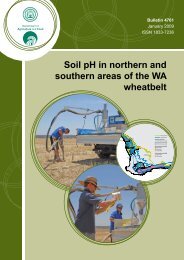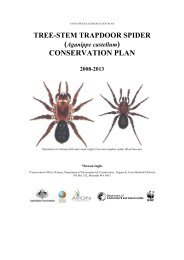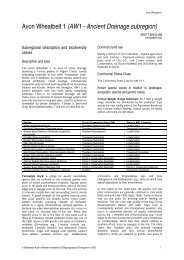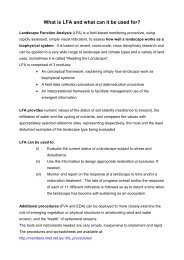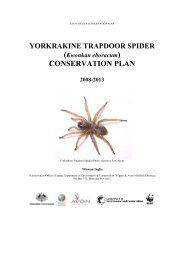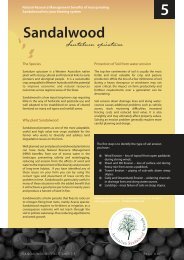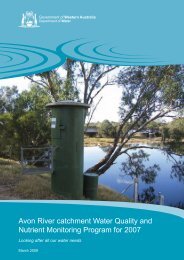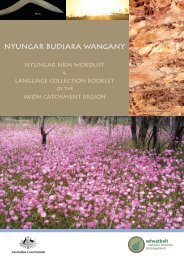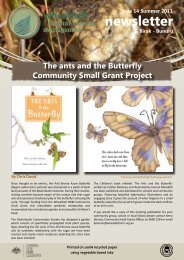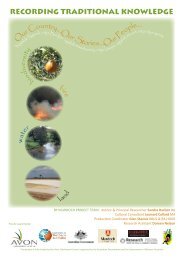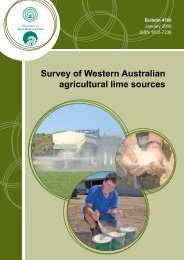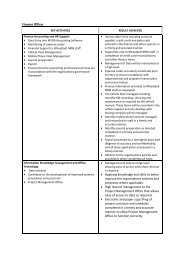Kokerbin Nature Reserve Desktop Fauna ... - Wheatbelt NRM
Kokerbin Nature Reserve Desktop Fauna ... - Wheatbelt NRM
Kokerbin Nature Reserve Desktop Fauna ... - Wheatbelt NRM
You also want an ePaper? Increase the reach of your titles
YUMPU automatically turns print PDFs into web optimized ePapers that Google loves.
<strong>Kokerbin</strong> <strong>Nature</strong> <strong>Reserve</strong><br />
<strong>Desktop</strong> <strong>Fauna</strong> Assessment<br />
2.2 Vegetation<br />
The majority of the vegetation in the region has been cleared for agriculture. Native<br />
vegetation that remains generally occurs in small and isolated remnants and many<br />
areas are degraded by grazing, fire, rising salinity and weed invasion. The vegetation<br />
of the region is described by Tille (2006) as:<br />
“Much has been cleared for agricultural development. In their natural state, the<br />
northern sandplains support acacia-Allocasuarina-melaleuca thickets. Species present<br />
include tammar (Allocasuarina campestris), Melaleuca uncinata, M. cordata, Acacia<br />
neurophylla, A. beauverdiana, A. resinomarginea and bull mallee (Eucalyptus<br />
pyriformis). In the south is a proteaceous scrub-heath of Dryandra, Allocasuarina,<br />
Banksia, Hakea, Grevillea and Acacia spp. Scrub-heaths with Banksia and<br />
Xylomelum angustifolium also occur on these sandplains.<br />
Common species west of the Meckering line are woodlands of York gum and wandoo<br />
with salmon gum, morel and gimlet. York gum and jam are found on the loamy soils<br />
over fresh rock. There is also some tammar thickets, proteaceous scrub-heaths and<br />
mallee on the lateritic residuals, with mallet (E. astringens) found below breakaways.<br />
On saline valley floors thickets of Melaleuca thyoides over samphire (Halosarcia<br />
spp.) can occur.”<br />
Granite outcropping is the major landform occurring within <strong>Kokerbin</strong> <strong>Nature</strong><br />
<strong>Reserve</strong>. Vegetation consists of woodlands and shrublands fringing the granite<br />
outcrops and vegetation associated with granite. The vegetation of the <strong>Kokerbin</strong><br />
<strong>Nature</strong> <strong>Reserve</strong> includes:<br />
- Wandoo (Eucalyptus wandoo) Woodland fringing the granite outcropping.<br />
Small areas occur fringing the granite outcropping.<br />
- Tammar (Allocasuarina campestris) shrubland and thickets and Kwongan<br />
Heath.<br />
- York Gum (Eucalyptus loxophleba) Woodland with Acacia acuminata.<br />
Sandalwood (Santalum spicatum), and a diversity of native annual species (eg<br />
Family Asteraceae and Family Apiaceae) and native grasses.<br />
- Calicopeplus paucifolius (tall broombush-like shrubs) / Tall Acacia shrubland<br />
and thickets fringing granite outcropping. This vegetation sometimes includes<br />
intermittent York Gums (Eucalyptus loxophleba), and occurs at the base of the<br />
granite outcropping. It is likely to be dependant on runoff from the large<br />
granite outcrops.<br />
- Granite Outcrop vegetation includes Borya sp., Kunzea pulchella, Tea Tree<br />
(Leptospermum sp.),, Melaleuca spp., Acacia lasiocalyx and sporadic stands of<br />
Caesia Gum (Eucalyptus caesia).<br />
<strong>Kokerbin</strong> Rock dominates the area containing numerous micro-habitats for fauna<br />
including caves, rock crevices and ephemeral rock pools. The ephemeral rock pools<br />
are likely to be a significant resource for fauna.<br />
8



